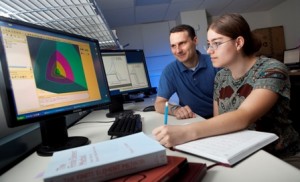
Professor Josh Smith and Kathleen Starkweather '11
Engineering runs in Kathleen Starkweather’s family.
“Both my parents are engineers,” she says. “It hasn’t seemed odd for me to be a female engineer, perhaps in part because my mom is one too.”
As a mechanical engineering major, Starkweather ’11 (Cincinnati, Ohio) has always enjoyed finding ways to make things work, and her summer research experience provided plenty of opportunities to exercise her skills.
She spent the summer in Japan with Joshua Smith, assistant professor of mechanical engineering, assisting in his ongoing research into techniques for dispersing medications through the brain.
For the second year in a row, Smith was awarded a grant by the Institute of Fluid Science at Tohoku University to conduct the research in collaboration with Kenichi Funamoto, an assistant professor at the university.
Starkweather worked alongside Smith all summer as an EXCEL Scholar. In addition to assisting Smith with the research that he is doing with Funamoto, she also helped him with work he is doing with Professor Jose Jaime Garcia at the Universidad del Valle in Colombia. Although the projects are separate, both explore aspects of drug delivery in brain tissue.
The research involved modeling fluid flow into the brain in a process called convection-enhanced delivery (CED). CED gets medicine into the brain through direct infusion. Computer models are used to predict how the infusion would affect the brain tissue.
“We used two main computer models. One was developed by Professor Smith and was fully three dimensional, but did not model some of the physical behavior of brain tissue. The second was developed by García. This model assumed spherical symmetry but modeled more accurately the way brain tissue is known to physically behave,” Starkweather explains.
The computer simulations will be compared with actual test results to verify the accuracy of the simulation and find ways to improve it, Starkweather says.
For Smith’s collaboration with Funamoto, Starkweather did programming work which made it possible to run simulations using the computer model. It took Starkweather about two months to complete the task, which Smith says would have taken much longer without her help.
Starkweather’s other major project while in Japan was to analyze the data produced by García’s code. “We ran simulations to see how having more or less infused fluid absorbed into blood vessels in the brain would change the effects of infusion. This research could suggest different ways for doctors to more safely administer CED,” she says.
Starkweather plays the French horn in the Concert Band and was a member of the College’s Forensic Society. She also spent a semester abroad in Germany and was part of a three-week, faculty-led course exploring environmental science in New Zealand.

1 Comment
Comments are closed.